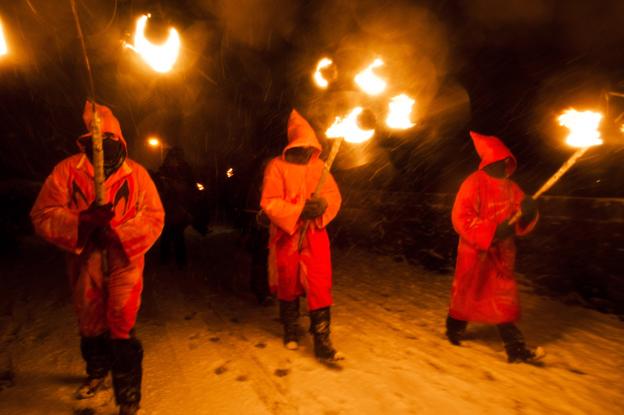Who, what, why: Is there really a Satanic New Year?
- Published

Suggestions that a piece of cloth stained with the blood of Pope John Paul II might have been stolen to coincide with "Satanic New Year" made the headlines this week. But is there really such a thing, asks Kathryn Westcott.
The cloth has been recovered and it is now thought the theft has nothing to do with Satanism. But the idea that devil-worshipers might mark New Year's Eve on the night of 1 February remains.
Italian religious studies teacher Giovanni Panunzio had been quoted earlier in the week, external as saying that the date of the theft coincided with a date in the Satanic calendar when "blood and crosses are symbolic objects to desecrate." So where does the notion that Satanists celebrate particular "holidays" come from?
A so-called Satanic calendar containing dozens of dates does exist. Its origins, however, are unclear. Versions of it can be found largely on websites belonging to Christian groups or TV stations. In a interview with the Christian Watchman Fellowship a few years ago, Dr Bill Ellis, an expert on folklore and the occult in contemporary culture, suggested the calendar, external first appeared in 1987 in a magazine article. "As critics later pointed out, the dates were borrowed uncritically from a wide range of sources, including the 15th Century witch-hunters' manual, the Malleus Malificarum," Ellis was quoted as saying.

The Pagan Imbolc celebrations focus on the lighting of fires
The so-called calendar lists 2 February as the date on which Satanic sexual and blood rituals are carried out. The same date in the Christian calendar is Candlemas, which commemorates the purification of Mary after giving birth. Pagans, however, will be celebrating Imbolc - the awakening of the land and the growing power of the Sun.
"The connection between Satanists and 1 February is purely imaginary," says Jesper Aagaard Petersen, associate professor at the Norwegian University of Science and Technology, who has a PhD in religious studies. He said many cultures have had light festivals in the late winter, some still do, and older traditions coexist with more recent ones in many parts of the world, including Britain, central Europe and Scandinavia. "In addition, neo-pagans and heathens have revived and elaborated on old Norse and celtic festivals, something surely noticed by evangelicals and conservative Catholics. In this sense, Satanists and witches have traditionally been conflated and still are," says Petersen. "Regarding Satanists, they are few and far between and have no doctrinal calendar to unite them."
According to Dr David Bromley, professor, religious studies and sociology at Virginia Commonwealth University, there are a number of actual Satanic groups, such as the Church of Satan, Temple of Set and Order of Nine Angels as well as "many lesser known groups". "Some of these groups have their own calendars, as many religious traditions do. The allegations of a massive underground network of Satanists has now been discredited, but there are still small groups attempting to keep this narrative alive. One part of this is constructing beliefs, practices, dates, shadowy figures, victims to hold the story together."
So, fear not the stranger clad in black on Saturday night. He or she is more likely to be a harmless teenage goth, than a disciple of Lucifer intent on invoking the Forces of Darkness.
Follow @BBCNewsMagazine, external on Twitter and on Facebook, external